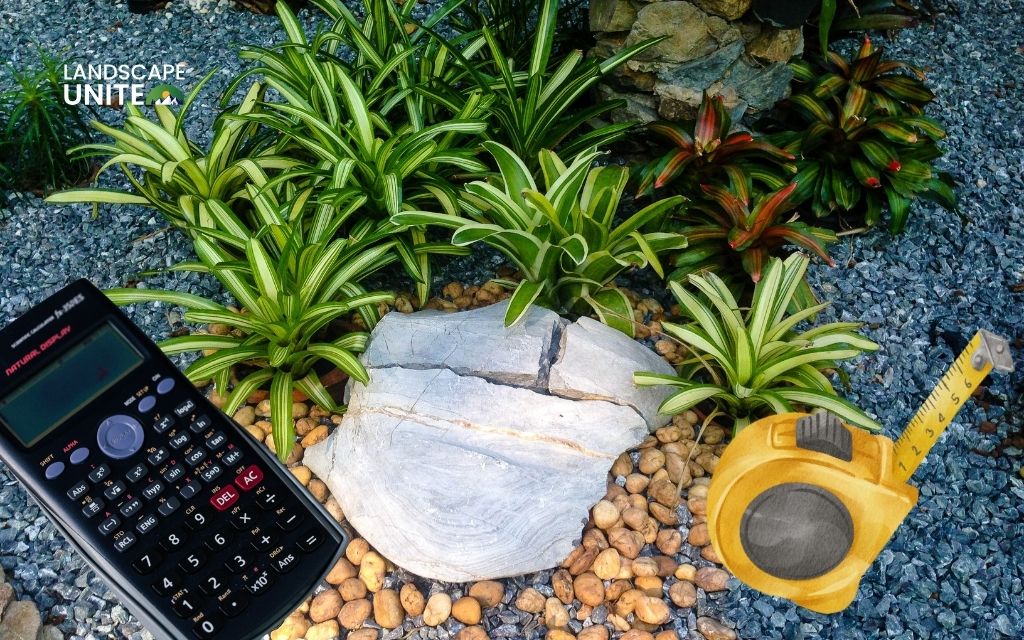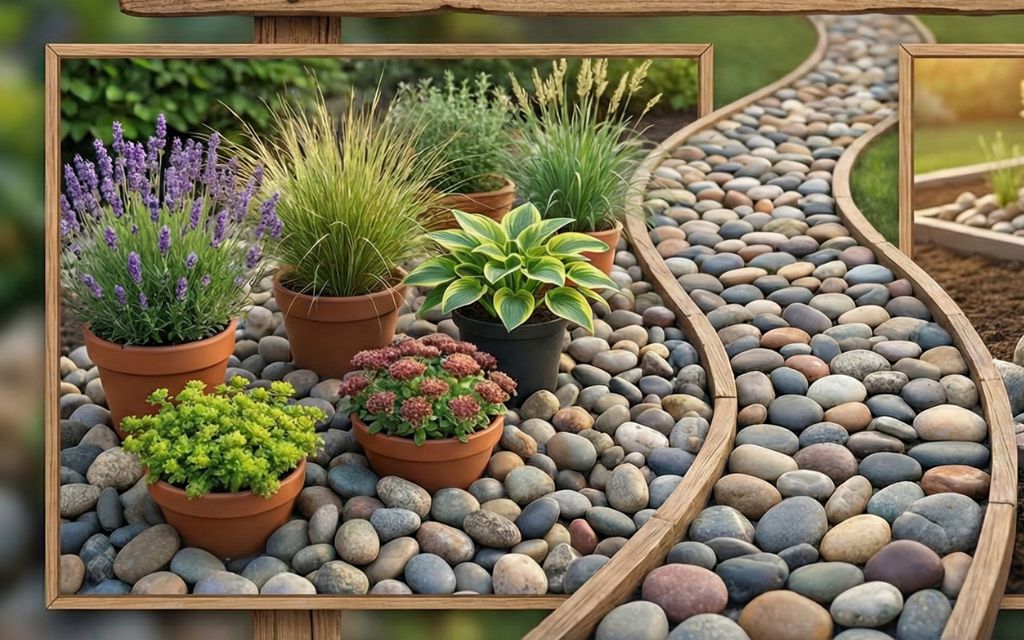There’s a reason marigolds have been garden favorites for generations. These flowers bring vibrant blooms in sunny yellows, fiery oranges, and rich reds to any landscape, and they’re remarkably forgiving for gardeners of all skill levels.
Whether you’re planting your first flower bed or you’re a seasoned gardener looking to add companion plants to your garden, this guide will walk you through everything you need to know about how to plant marigolds.
From selecting the perfect variety to caring for your plants through a long season of blooms, you’ll discover why marigolds deserve a spot in every American garden. Let’s dig in!
Why grow marigolds?
Beauty & seasonal color
A garden of marigolds creates an instant focal point with bright yellows, oranges, and reds that complement nearly any landscape design.
Unlike many flowering plants that bloom briefly and fade, marigolds offer a remarkably long bloom period – often continuing for 4 to 5 months with minimal effort on your part.
This extended display means continuous color and charm throughout the growing season, making them an excellent investment for gardeners who want maximum impact with minimal fuss.
Natural pest control benefits
Here’s where marigolds truly shine beyond their good looks.
Marigold flower planting isn’t just about aesthetics – it’s a strategic garden defense system. These plants produce compounds in their roots and foliage that naturally repel destructive pests including root-knot nematodes, aphids, whiteflies, and even some beetles.
Vegetable gardeners have long planted marigolds alongside tomatoes, peppers, squash, and other crops as a companion planting strategy.
The French marigold, in particular, has been scientifically shown to reduce nematode populations in soil, protecting the roots of neighboring plants from these microscopic pests.
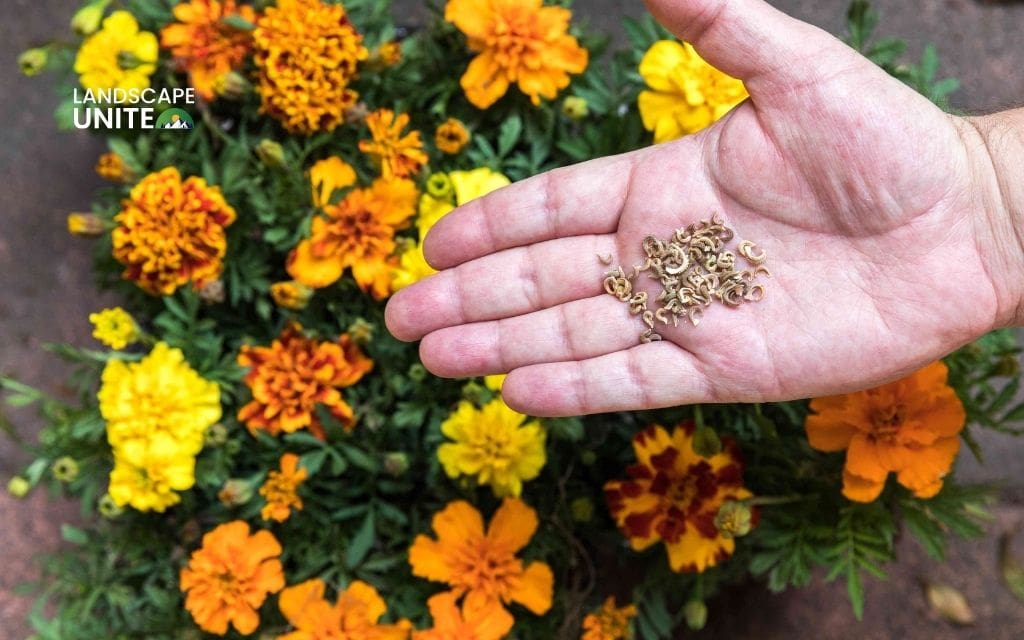
Easy-care & versatile
Marigolds thrive in different soils and climates across the United States, from the hot, dry conditions of the Southwest to the humid summers of the Southeast.
They’re remarkably adaptable plants that forgive beginner mistakes while still rewarding experienced gardeners with abundant blooms.
Whether you’re working with garden beds, borders, containers, or window boxes, there’s a marigold variety perfectly suited to your space. Their low-maintenance nature means you’ll spend more time enjoying your garden and less time worrying about finicky plants.
Choosing the right marigold variety
Not all marigolds are created equal, and selecting the right variety for your specific needs will set you up for success. Here are the main types you’ll encounter:
African Marigold (Tagetes erecta)
These are the tall, stately performers of the marigold world, reaching heights of 12 to 36 inches with large, globe-shaped blooms that can measure 3 to 5 inches across.
African marigolds work beautifully as backdrop plants in borders or as cut flowers for arrangements. Their substantial size makes them excellent statement plants, though they may need staking in windy locations.
French Marigold (Tagetes patula)
Compact and bushy, French marigolds typically grow 6 to 12 inches tall with smaller, often bi-colored blooms. These are ideal for edging pathways, tucking into vegetable gardens, or growing in pots and containers.
They’re the variety most often recommended for pest control purposes and tend to bloom prolifically throughout the season.
Signet Marigold (Tagetes tenuifolia)
Sometimes called gem marigolds, these delicate beauties feature fine, lacy foliage and small, single flowers. They’re notably less pungent than other varieties, and their edible flowers add a citrusy flavor to salads and garnishes.
Signet marigolds grow 8 to 12 inches tall and create a delicate, refined look in borders.
Pot Marigold (Calendula officinalis)
Technically a calendula rather than a true marigold, pot marigolds are often grouped with marigolds in garden centers.
These cool-season bloomers prefer spring and fall temperatures and are entirely edible, with petals commonly used in teas, salads, and herbal remedies.

When to plant marigold seeds
Timing is everything when it comes to successful marigold plant growing.
- For indoor seed starting, begin 6 to 8 weeks before your area’s last expected frost date. This gives marigold seedlings time to develop strong root systems before transplanting outdoors.
- For direct outdoor sowing, patience pays off. Wait until all danger of frost has passed and soil has warmed considerably.
Marigold seeds won’t germinate well in cold, wet soil and may simply rot. Most gardeners find that planting marigolds outdoors works best from mid-April through June, depending on location.
When to sow marigolds outdoors really depends on your specific USDA hardiness zone and local weather patterns.
Step-by-step guide: How to plant marigolds
Let’s walk through the planting process from start to finish. Whether you’re planting marigold seeds directly in the garden or starting them indoors, these steps will ensure success.
Step 1: Prepare the soil
Start with well-drained, moderately fertile soil. Marigolds aren’t heavy feeders – in fact, overly rich soil can lead to lush foliage but fewer blooms.
Work the soil to a depth of 6 to 8 inches, breaking up any clumps and removing rocks or debris. If your soil is particularly poor or heavy clay, mix in 2 to 3 inches of compost to improve structure and drainage.
A slightly acidic to neutral pH (6.0 to 7.0) is ideal, though marigolds are quite forgiving of pH variations.
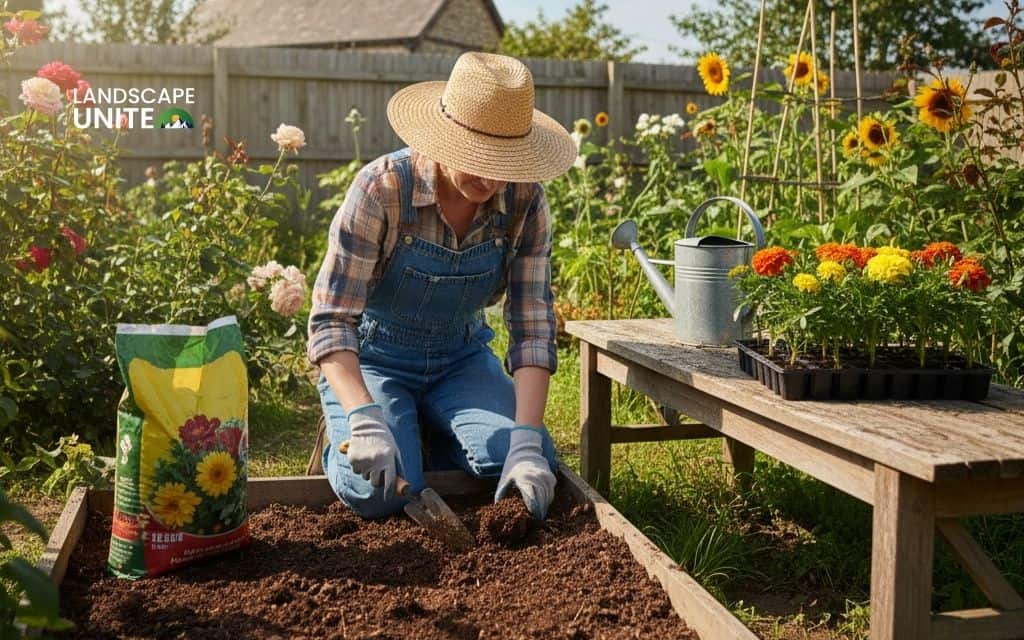
Step 2: Planting marigold seeds
When planting marigolds from seed, sow them approximately ¼ inch deep – they need just enough soil coverage to maintain moisture while allowing light to penetrate (marigold seeds benefit from some light exposure during germination).
Space seeds 2 to 3 inches apart initially; you’ll thin them later. Lightly cover with soil or vermiculite and gently press down to ensure good seed-to-soil contact.
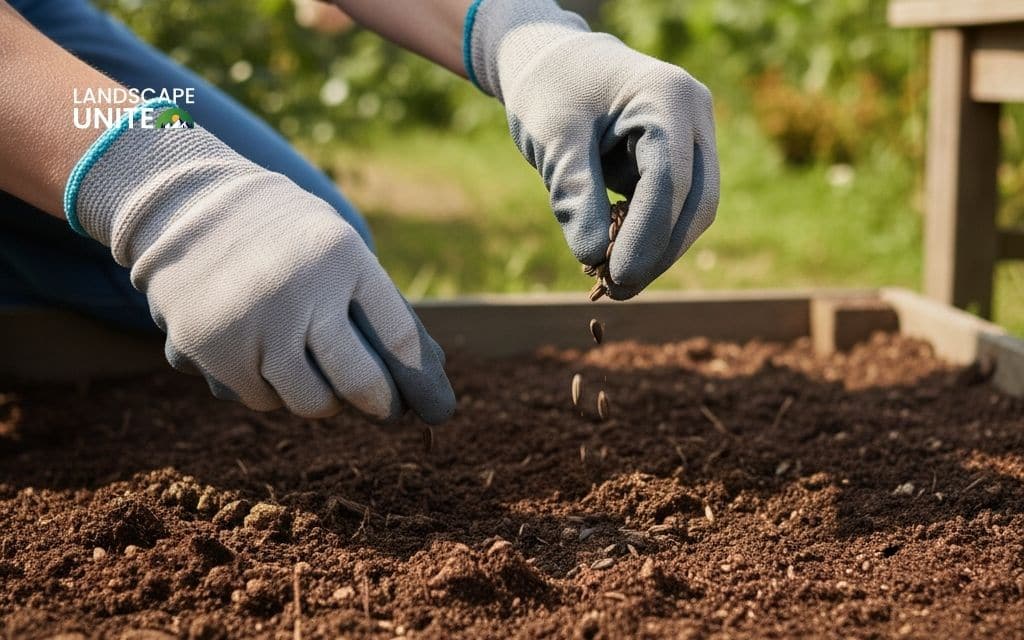
Step 3: Watering
Keep soil consistently moist but not soggy until seedlings appear, which typically takes 5 to 7 days in warm soil.
Water gently to avoid washing away seeds – a spray bottle or misting attachment works well for newly planted seeds.
Once you see those first green shoots emerging, you can gradually reduce watering frequency while ensuring the soil doesn’t completely dry out.
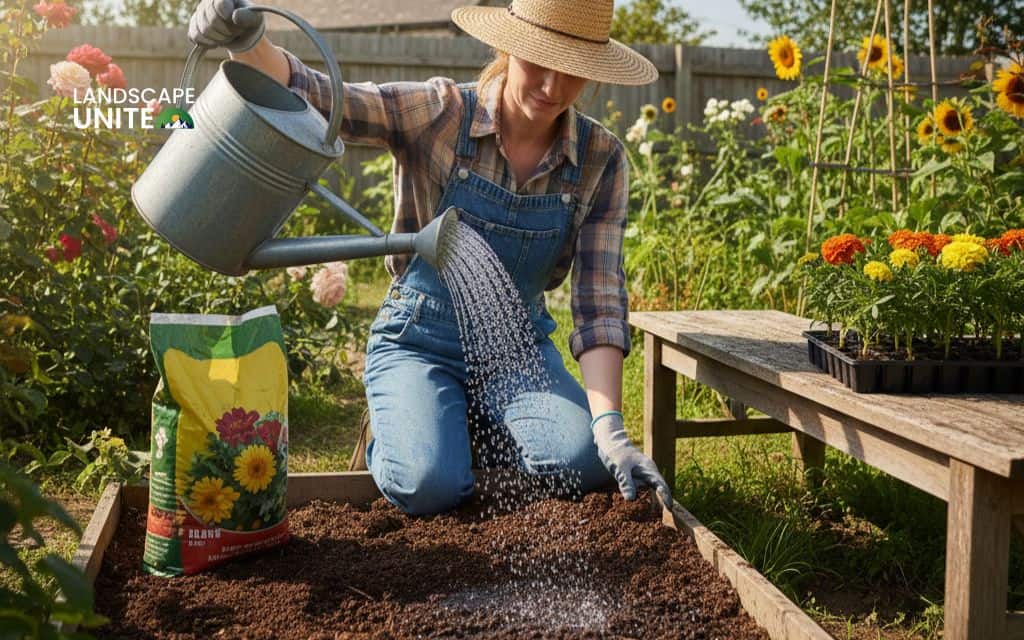
Step 4: Transplanting marigold seedlings
Thin or transplant marigold seedlings when they reach 2 to 3 inches tall and have developed at least 2 sets of true leaves (the leaves that appear after the initial seed leaves).
If you started seeds indoors, harden off seedlings by gradually exposing them to outdoor conditions over 7 to 10 days before transplanting. This adjustment period prevents shock and helps plants acclimate to wind, direct sun, and temperature fluctuations.
When transplanting, dig holes slightly larger than the root ball, set plants at the same depth they were growing previously, and firm soil gently around roots. Water immediately after transplanting to help settle soil and eliminate air pockets.
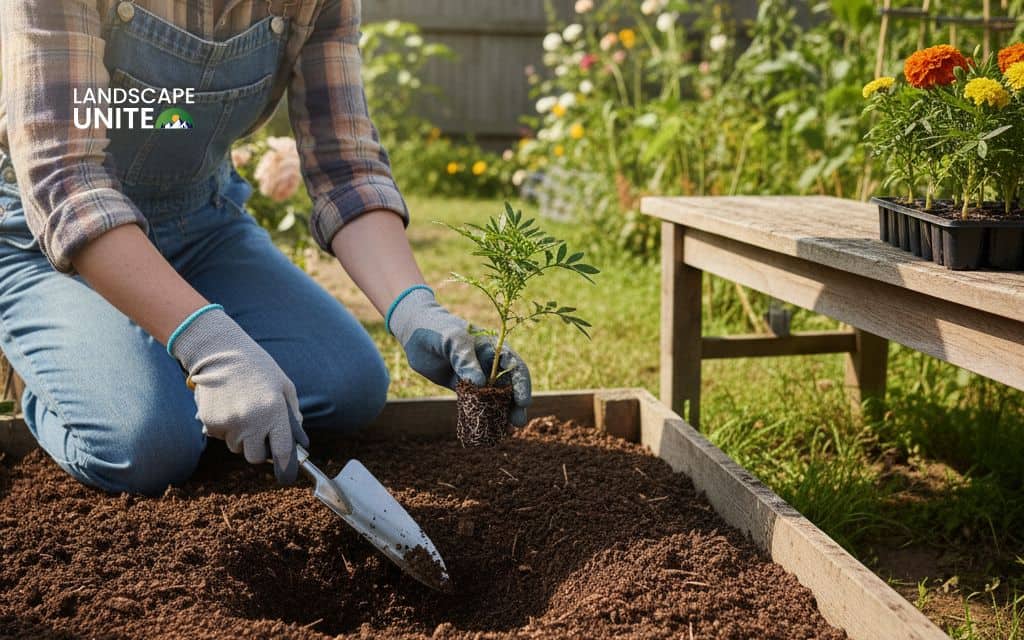
Step 5: Spacing
Proper spacing prevents disease and promotes healthy air circulation.
- African marigold varieties need 12 to 18 inches between plants due to their larger mature size.
- French marigold spacing should be 6 to 9 inches apart – close enough for a full appearance but with room for air movement.
- Signet marigolds can be planted 8 to 10 inches apart.
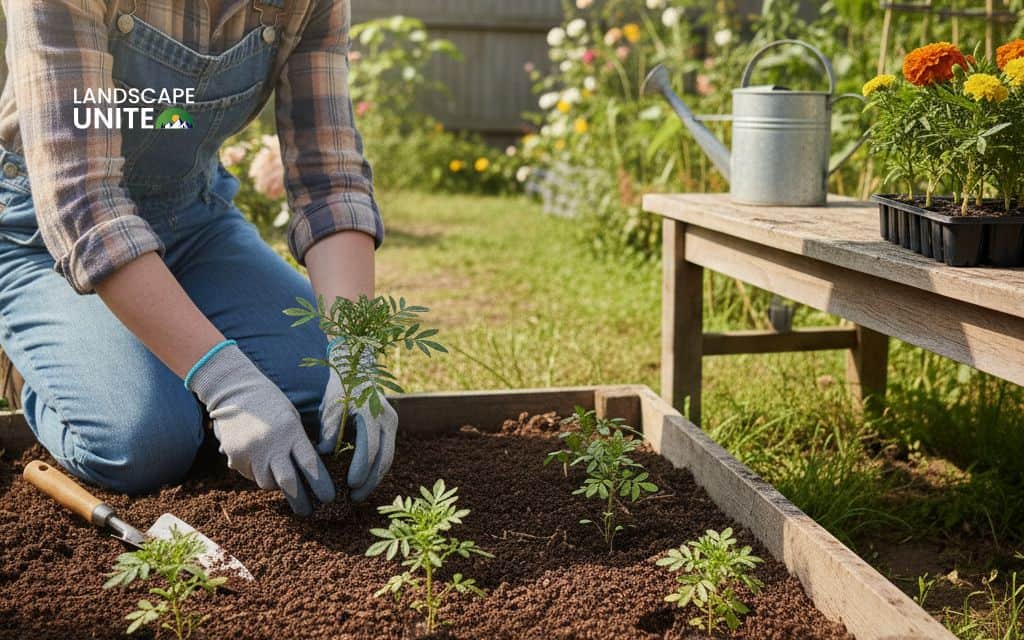
Step 6: Mulching
Add a 2 to 3-inch layer of organic mulch around your marigolds, keeping it a few inches away from plant stems to prevent rot.
Mulch retains moisture during hot weather, moderates soil temperature, and significantly reduces weed competition.
Shredded bark, straw, or compost all work well as mulch materials.

Caring for marigolds after planting
Watering
Water deeply once or twice weekly, providing about 1 inch of water total. Deep, infrequent watering encourages strong root development, while shallow, frequent watering creates weak, surface-level roots. Marigolds during hot summer months may require more frequent watering, especially for container-grown plants.
Avoid overhead watering whenever possible, as wet foliage invites fungal diseases. Instead, direct water at the soil level using soaker hoses or drip irrigation. If you must use overhead sprinklers, water early in the morning so foliage dries quickly as the day warms.
Fertilizing
Marigolds thrive with light feeding every 4 to 6 weeks using a balanced, water-soluble fertilizer.
However, here’s an important tip: avoid fertilizers high in nitrogen, which encourage excessive leaf growth at the expense of flower production. A 5-10-10 or similar low-nitrogen formula works best.
Many gardeners find that marigolds planted in reasonably fertile soil don’t need any fertilization at all – these plants are naturally frugal and bloom happily in average conditions.
Deadheading & pruning
Remove spent flowers regularly to encourage continuous blooming and keep plants looking tidy.
This process, called deadheading, redirects the plant’s energy from seed production back into creating new flowers. Simply pinch off faded blooms just above the next set of leaves.
For bushier, more compact plants, pinch stem tips when plants are young, removing just the top ½ inch of growth. This encourages lateral branching and results in fuller plants covered with more blooms.
Common pests & diseases
While marigolds repel many pests, they’re not entirely immune to problems.
- Watch for spider mites, which appear as tiny specks on leaf undersides and cause stippled, yellowing foliage.
- Aphids occasionally cluster on new growth, sucking plant sap and potentially transmitting diseases.
- Powdery mildew – a white, powdery fungal coating on leaves – can occur in humid conditions with poor air circulation.
Control these issues through good cultural practices: proper spacing for air circulation, avoiding overhead watering, and promptly removing affected plant parts.
Companion planting marigolds themselves helps reduce pest infestations throughout your garden, but you can also use insecticidal soap for severe aphid or spider mite problems.
Where to buy marigold seeds or plants
Your best sources for quality marigold seeds and plants include local garden centers and nurseries, where staff can recommend varieties proven to perform well in your specific climate.
Spring is prime time for finding marigold seedlings ready to transplant, usually available from late March through early June.
For seed selection, trusted online seed companies like Burpee, Johnny’s Selected Seeds, and Park Seed offer extensive marigold varieties, including heirloom and specialty types you won’t find locally.
When selecting healthy seedlings in person, look for compact, bushy plants with deep green foliage and no yellowing or leggy growth.
Avoid plants already covered in flowers – younger plants with buds rather than open blooms establish more quickly and bloom longer.
Conclusion
Marigolds truly are the easy, beautiful, pest-repelling garden stars that every gardener deserves. From the towering elegance of African marigolds to the compact charm of French varieties, these versatile flowers deliver months of vibrant color while actively improving garden health.
How to plant marigold seeds and care for these resilient bloomers isn’t complicated – just provide full sun, well-drained soil, and occasional watering, and you’ll be rewarded with a spectacular display.
Want more tips on caring for your flower beds? Don’t wait. Explore our garden knowledge library now.
Frequently asked questions (FAQs)
How do I plant marigolds from seed?
Sow marigold seeds ¼ inch deep in warm soil (65 – 75°F), spacing them 2 to 3 inches apart. Keep soil consistently moist but not waterlogged until germination, which typically occurs within 5 to 7 days. Once seedlings develop two sets of true leaves and reach 2 to 3 inches tall, thin them to proper spacing or transplant to their permanent location.
When do marigolds bloom after planting?
Most marigolds bloom 8 to 10 weeks after seeding when grown under optimal conditions. If you transplant nursery-grown seedlings that already have buds, you may see flowers within 1 to 2 weeks of planting. Marigolds continue blooming prolifically until the first hard frost kills them in fall, making them one of the longest-blooming annuals you can grow.
Can marigolds be grown in pots?
Absolutely! Compact varieties like French marigolds are perfect for containers and patios. Choose pots at least 8 to 10 inches in diameter with drainage holes, fill with quality potting mix, and water more frequently than garden-planted marigolds since containers dry out faster.
Do marigolds come back every year?
Most marigolds (Tagetes species) are annuals, meaning they complete their life cycle in one growing season and don’t survive winter. However, marigolds are enthusiastic self-seeders in favorable conditions. If you leave spent flowers on plants in fall rather than deadheading, seeds will scatter and may germinate the following spring, creating “volunteer” seedlings that appear to return on their own.
Are marigolds safe for pets and edible?
French and African marigolds (Tagetes varieties) are non-toxic to dogs, cats, and other pets, though their strong scent usually deters animals from eating them. While not harmful, these marigolds aren’t particularly palatable. Pot marigolds (calendula) are entirely different – they’re edible flowers often used in teas, salads, and as natural food coloring, and they’re also safe for pets. Always verify specific varieties before consuming any flowers.
What month is best to plant marigolds?
The best month to plant marigolds varies by your location, but generally late April through May is ideal for most US gardeners. If starting seeds indoors, begin in February or March (6-8 weeks before your last frost date) for earlier blooms.
How many marigolds should you plant together?
For the best visual impact, plant marigolds in groups of at least 3 to 5 plants of the same variety. Odd numbers (3, 5, 7, 9) create a more natural, aesthetically pleasing look than even numbers.
What is the secret to growing marigolds?
The secret is full sun, well-drained soil, and avoiding overwatering. Marigolds thrive on benign neglect – they prefer slightly dry conditions over constantly moist soil and bloom better in average soil than overly rich soil.
